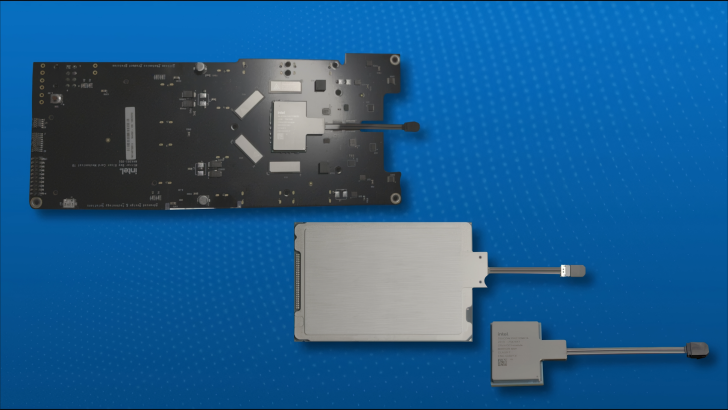Intel has achieved a breakthrough in the photonics segment, unveiling the world's first fully integrated optical compute interconnect for emerging AI markets.
Intel's Newest Interconnect Solution Targets To Replace Traditional I/O Connections Through Newer Standards
When we talk about the world of interconnects and how vital they have been for the AI markets, the prospects of photonics are discussed plenty of times, and it looks like Team Blue has finally come up with a solution. Their newest press release reveals that Intel's Integrated Photonics Solutions (IPS) Group has developed the industry's first OCI interconnect chiplet, which is seen as a gigantic milestone for the markets, considering the performance improvements the technology will bring onboard.

The ever-increasing movement of data from server to server is straining the capabilities of today’s data center infrastructure, and current solutions are rapidly approaching the practical limits of electrical I/O performance. However, Intel’s groundbreaking achievement empowers customers to seamlessly integrate co-packaged silicon photonics interconnect solutions into next-generation compute systems.
Our OCI chiplet boosts bandwidth, reduces power consumption and increases reach, enabling ML workload acceleration that promises to revolutionize high-performance AI infrastructure
- Thomas Liljeberg, Senior Director, Product Management and Strategy, Integrated Photonics Solutions (IPS) Group
Diving into the specifics, Intel says that their newest OCI chiplet offers significantly higher bandwidth data transfer through co-packaged optical input/output and supports up to 64 channels at 32 Gbps data transmission speeds. Some of the benefits of optical I/O interconnects include:
- Better Bandwidth
- Higher Energy Efficiency
- Lower Latency
- Longer Reach
The technology can also scale up distances, now supporting up to 100 meters of fiber optics. Compared to the traditional "Electrical I/O," Team Blue has increased distances by a whopping 100 times, a massive milestone for the AI markets. The firm says that going from electrical to optical is like switching from "horse carriages" to "motor vehicles," so you can imagine the extent of improvements we are discussing.

Regarding how Intel's newest OCI works, the firm employs a silicon photonics integrated circuit (PIC) that includes other elements for transmitting data through light. The first implementation reportedly supports 4 terabits per second (Tbps) bidirectional data transfer and comes with a co-packaged design, making it much more power-efficient and faster.

The sole aim of Intel here is to overcome the barriers present in traditional electrical I/O connections and create an efficient solution that caters to the rapidly growing AI markets.
How It Works: The fully Integrated OCI chiplet leverages Intel’s field-proven silicon photonics technology and integrates a silicon photonics integrated circuit (PIC), which includes on-chip lasers and optical amplifiers, with an electrical IC. The OCI chiplet demonstrated at OFC was co-packaged with an Intel CPU but can also be integrated with next-generation CPUs, GPUs, IPUs and other system-on-chips (SoCs).
This first OCI implementation supports up to 4 terabits per second (Tbps) bidirectional data transfer, compatible with peripheral component interconnect express (PCIe) Gen5. The live optical link demonstration showcases a transmitter (Tx) and receiver (Rx) connection between two CPU platforms over a single-mode fiber (SMF) patch cord. The CPUs generated and measured the optical Bit Error Rate (BER), and the demo showcases the Tx optical spectrum with 8 wavelengths at 200 gigahertz (GHz) spacing on a single fiber, along with a 32 Gbps Tx eye diagram illustrating strong signal quality.
The current chiplet supports 64 channels of 32 Gbps data in each direction up to 100 meters (though practical applications may be limited to tens of meters due to time-of-flight latency), utilizing eight fiber pairs, each carrying eight dense wavelength division multiplexing (DWDM) wavelengths. The co-packaged solution is also remarkably energy efficient, consuming only 5 pico-Joules (pJ) per bit compared to pluggable optical transceiver modules at about 15 pJ/bit. This level of hyper-efficiency is critical for data centers and high-performance computing environments and could help address AI’s unsustainable power requirements.
About Intel’s Leadership in Silicon Photonics: As a market leader in silicon photonics, Intel leverages more than 25 years of internal research from Intel Labs, which pioneered integrated photonics. Intel was the first company to develop and ship silicon photonics-based connectivity products with industry-leading reliability at high volume to major cloud service providers.
Intel’s main differentiator is unparalleled integration using hybrid laser-on-wafer technology and direct integration, which yield higher reliability and lower costs. This unique approach enables Intel to deliver superior performance while maintaining efficiency. Intel’s robust, high-volume platform boasts shipping over 8 million PICs with over 32 million integrated on-chip lasers, showing a laser failures-in-time (FIT) rate of less than 0.1, a widely utilized measure of reliability that represents failure rates and how many failures occur.
These PICs were packaged in pluggable transceiver modules, deployed in large data center networks at major hyperscale cloud service providers for 100, 200, and 400 Gbps applications. Next generation, 200G/lane PICs to support emerging 800 Gbps and 1.6 Tbps applications are under development.
Intel is also implementing a new silicon photonics fab process node with state-of-the-art (SOA) device performance, higher density, better coupling and vastly improved economics. Intel continues to make advancements in on-chip laser and SOA performance, cost (greater than 40% die area reduction) and power (greater than 15% reduction).

With Intel officially entering the "silicon photonics" segment, it will be interesting to see how the markets respond to the new development, considering that the technology has been discussed for quite some time now, and Team Blue is fairly ahead in the race.
News Source: Intel





